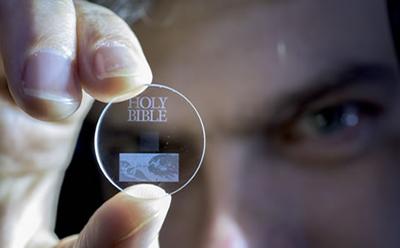
Data storage solutions are constantly evolving, from the bygone days of floppy disks to modern hard drives and solid-state drives. Occasionally these developments have huge impacts for the future of our society and how we’ll all be remembered, and what researchers at the University of Southampton’s Optical Research Center announced this last Tuesday could be just such a development. Using a revolutionary technique these researchers have found that they can store up to 360TB of data on a single “5D” disk, and that the resulting structure is so stable that the data could last up to 13.8 billion years and withstand temperatures up to 1000 degrees Celsius.
The technology works by manipulating three layers of nanoscale-level dots on a disk of specially structured glass using bursts of laser that last only femtoseconds. By changing the dot size and orientation as well as its position within the three layers the researchers can change the polarization of the light traveling through the disk, which can then be interpreted using a microscope and a polarizer.
The result is an incredibly dense data structure that stores terabytes in millimeters rather than inches. To give the discovery some scale, one of our most popular hard drives for any PC build is the WB Blue HDD, which carries up to 4TBs of data in a 3.5 inch package. In order to get the same capacity out of these HDDs as this new 5D disc technology, we would need 90 WD Blues to equate to a single 360TB quarter-sized disk. It’s a massive step forward for data storage and represents the first time we’ve seen a system that could potentially preserve the human race’s entire history and cumulative knowledge in a safe and stable manner long after we’ve come and gone.
Human history preserved on disks
Professor Peter Kazansky, a researcher on the project, stated: “It is thrilling to think that we have created the technology to preserve documents and information and store it in space for future generations […] This technology can secure the last evidence of our civilization: all we’ve learned will not be forgotten.”
civilization: all we’ve learned will not be forgotten.”
There’s no word as to when (or even if) this technology will make its way down into consumer hands, but the potential for storing large quantities of data is mind boggling to say the least. And considering the technology’s reliance on light-based read/write tech, good odds say it would be at least as fast as SSD technology available today. Imagine a world where we can get the speed of an Intel 750 Series SSD or a Samsung 850 Pro but the capacity of 90 4TB drives, all in a device you could fit in your wallet!

